
Categorization
In Cognitive Computer Science
John F. Sowa
VivoMind LLC
UQÀM Summer Institute on Cognitive Science
30 June 2003


Categorization
Classification and categorization are fundamental to intelligence — in every species.
- Similarity: Recognition that two stimuli are signs of the same category.
- Identity: Recognition that two stimuli are signs of the same categories for all relevant purposes.
- Generalization/specialization: Recognition that some category includes another.
- Negation: Denial that some stimulus is a sign of some category.


Categorization and Reasoning
- Deduction: Applying a general principle to a special case.
- Induction: Deriving a general principle from special cases.
- Abduction: Guessing that some general principle can relate a given pattern of cases.
- Analogy: Finding a common pattern in different cases.


Peirce's Logic of Pragmatism
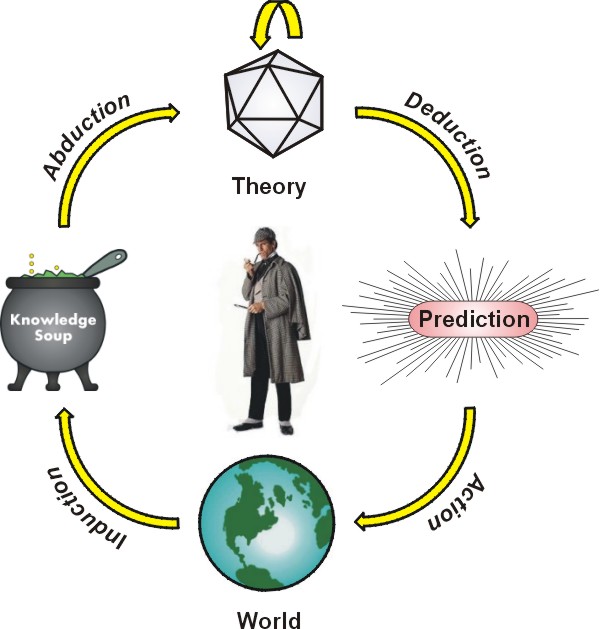


Sensory-Reasoning-Motor Cycle
- Induction: From observations to generalizations to the "knowledge soup."
- Abduction: Extract hypotheses from the soup to form a tentative theory.
- Revision: More abductions to revise the theory.
- Deduction: Use the theory to make predictions.
- Action: Test predictions by changing the world.
- Repeat from line #1.


Replacing Sherlock Holmes
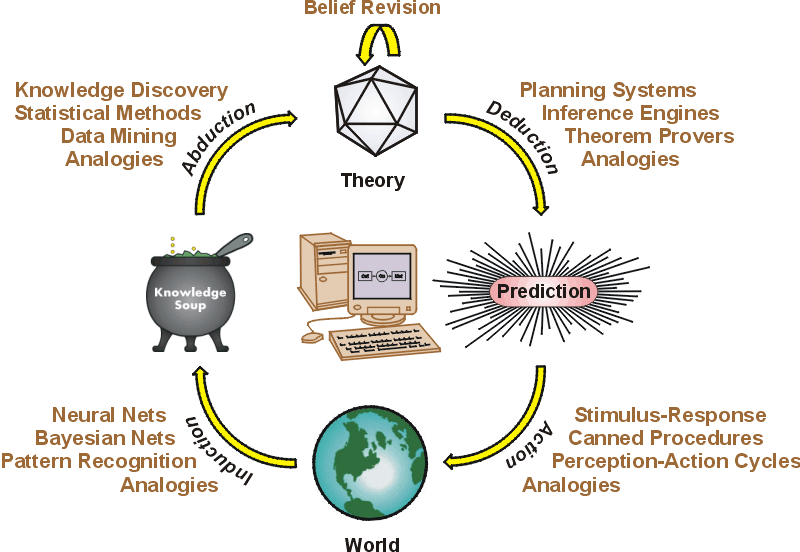


A Big Categorization Project
Cyc project started in 1984 by Doug Lenat.
- Name comes from the stressed syllable of encyclopedia.
- Goal: implement the commonsense knowledge of an average human being.
- After $65 million and 650 person-years of work,
600,000 categories
defined by 2,000,000 axioms
organized in 6,000 microtheories. - But it cannot compete with a 10-year-old child.


Cyc Review
Two-day DARPA-sponsored review of Cyc in June 2003 with about two dozen AI experts.
Consensus:
- Cyc is a unique and valuable resource:
A great deal has been learned from it.
Much more can be learned from it.
If it were canceled, something like it would have to be done again. - Support for Cyc should be continued.
- Cyc should be freely available for research purposes.
- But there are many questions about the relationship of Cyc to other R & D efforts.


Lexical Resources
Developers of WordNet (George Miller) and FrameNet (Chuck Fillmore) were also present.
Consensus:
- Lexical resources are complementary to Cyc.
- Extremely valuable for natural language projects.
- Desirable to integrate contributions from various sources.
- Integration would require relatively modest funding.
- Word senses (synsets) can be linked to the categories of Cyc and other axiomatized ontologies.


Feigenbaum's Question
Ed Feigenbaum asked why Cyc has taken so long to become "intelligent".
- In 1961, I. J. Good made a prediction:
It is more probable than not that, within the twentieth century, an ultraintelligent machine will be built and that it will be the last invention that man need make.
- Why hasn't Good's prediction come to pass?
- Is there some missing ingredient that the AI community hasn't discovered?
- What is it? Could it be added to Cyc?


Cyc's Piece of the Pie
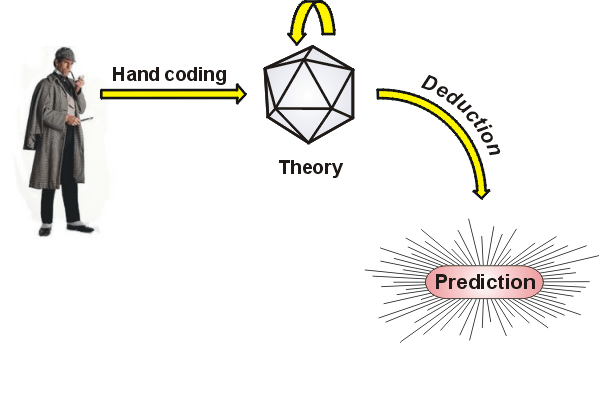
- Cyc does not replace Sherlock Holmes.
- It requires people like him to write axioms.
- At a cost of $10,000 to encode one page from a textbook.


Ibn Taymiyya Contra Aristotle
- Fourteenth century Moslem legal scholar.
- Admitted that deduction is necessary for pure mathematics.
- But for reasoning about the world, deduction is limited to the accuracy of the induction.
- Given the same data, analogy can replace induction + deduction.


Ibn Taymiyya's Argument
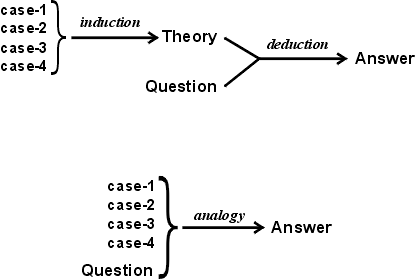
- A theory can be useful, if available.
- But analogy can be used when no theory exists.


VivoMind Analogy Engine
Three methods of analogy:
- Matching labels:
- Compare type labels on conceptual graphs.
- Matching subgraphs:
- Compare subgraphs independent of labels.
- Matching transformations:
- Transform subgraphs.
Methods #1 and #2 take (N log N) time.
Method #3 takes polynomial time (analogies of analogies).


Analogy of Cat to Car
| Cat | Car |
|---|---|
| head | hood |
| eye | headlight |
| cornea | glass plate |
| mouth | fuel cap |
| stomach | fuel tank |
| bowel | combustion chamber |
| anus | exhaust pipe |
| skeleton | chassis |
| heart | engine |
| paw | wheel |
| fur | paint |
VAE used methods #1 and #2.
Source data from WordNet mapped to CGs.


Matching Labels
Corresponding concepts have similar functions:
- Fur and paint are outer coverings.
- Heart and engine are internal parts with a regular beat.
- Skeleton and chassis are structures for attaching parts.
- Paw and wheel support the body, and there are four of each.


Matching Subgraphs
A pair of isomorphic subgraphs:
- Cat: head → eyes → cornea.
- Car: hood → headlights → glass plate.
Approximate match (missing esophagus and muffler):
- Cat: mouth → stomach → bowel → anus.
- Car: fuel cap → fuel tank → combustion chamber → exhaust pipe.


Relating Different Representations
Method #3 for relating data structures that represent equivalent information.
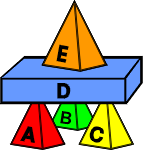
- A structure described in different ways:
- English description: "A red pyramid A, a green pyramid B, and a yellow pyramid C support a blue block D, which supports an orange pyramid E."
- A relational database would use tables.
- But many different options for chosing tables, rows and columns, and labels for the columns.


Representation in a Relational DB
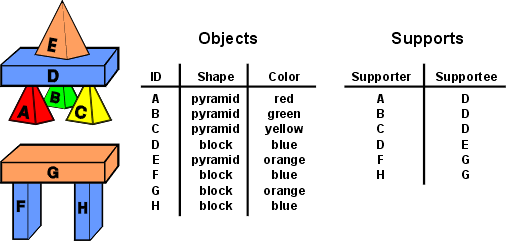


CG Derived from Relational DB
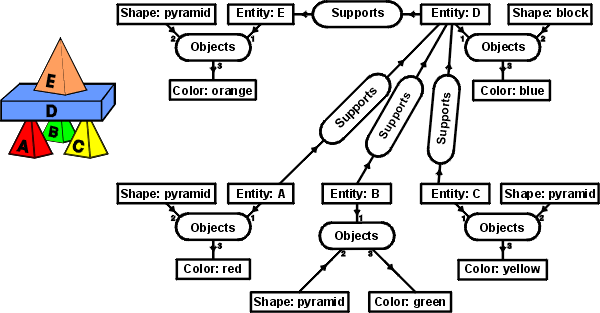


CG Derived from English
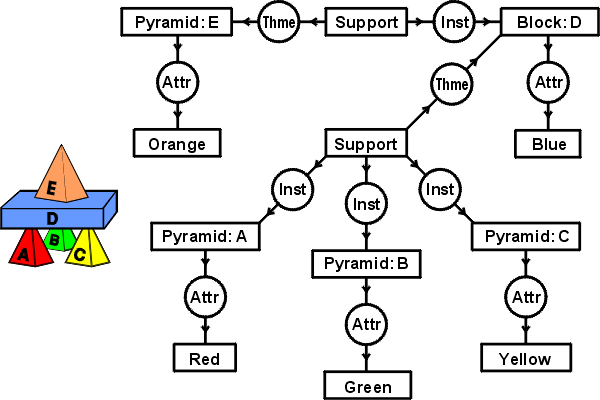
"A red pyramid A, a green pyramid B, and a yellow pyramid C support a blue block D, which supports an orange pyramid E."


The Two CGs Look Very Different
- CG from RDB has 15 concept nodes and 8 relation nodes.
- CG from English has 12 concept nodes and 11 relation nodes.
- No label on any node in the first graph is identical to any label on any node in the second graph.
- But there are some structural similarities.
- VAE uses method #3 to find them.


Transformations Found by VAE
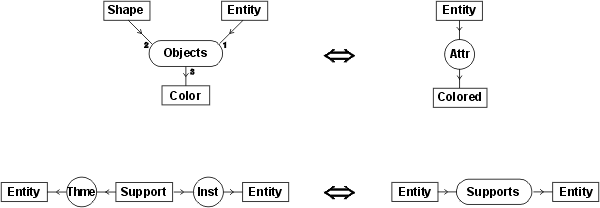
Top transformation applied to 5 subgraphs.
Bottom one applied to 4 subgraphs.
One application could be due to chance, but 4 or 5 contribute strong
evidence for the mapping.


Evolutionary Pragmatism
Worm: sensory-motor cycle.
Fish: sensory-analogy-motor cycle.
Mammal: sensory-reasoning-motor cycle.
Human: sensory-induction-abduction-deduction-motor cycle.
Higher organisms include all the capabilities of the lower forms.


References
Paper on analogical reasoning by Sowa and Majumdar:
http://www.jfsowa.com/pubs/analog.htm
Paper on ontology, metadata, and semiotics:
http://www.jfsowa.com/ontology/ontometa.htm
Peirce's tutorial on existential graphs, with commentary by Sowa:
http://www.jfsowa.com/peirce/ms514.htm
Selected papers by Peirce on semeiotic and related topics; see his 1903 lectures on pragmatism in vol. 2 for material related to this talk:
Peirce, Charles Sanders (EP) The Essential Peirce, ed. by N. Houser, C. Kloesel, and members of the Peirce Edition Project, 2 vols., Indiana University Press, Bloomington, 1991-1998.
Cyc web sites:
http://www.cyc.com/
WordNet web site:
http://www.cogsci.princeton.edu/~wn/
FrameNet web site:
http://www.icsi.berkeley.edu/~framenet/